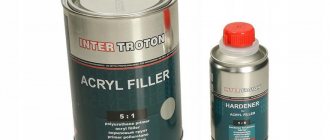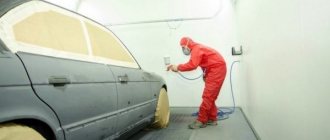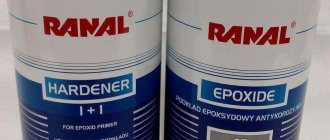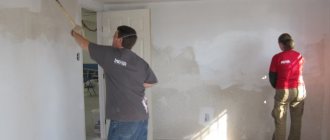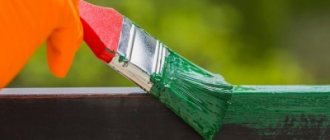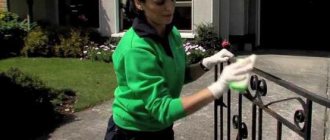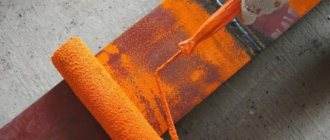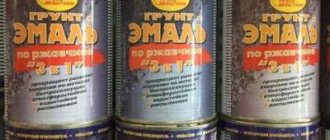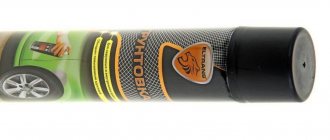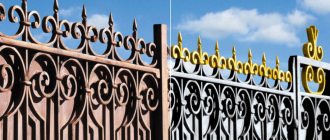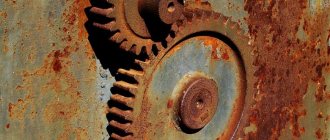When processing a car body to create a uniformly smooth surface, it is almost impossible to do without a primer. Correctly selected acid, epoxy or acrylic primer for a car creates additional protection, eliminates dents and irregularities, and ensures a tight fit of paintwork materials. The most popular due to its ease of use and quick-drying properties is acrylic. However, other types of primers have their own advantages and applications.
What is the soil for?
Automotive primer (from German der Grund - “soil”, “base”) is a specialized viscous mixture that tends to harden and acts as an intermediate layer between metal and paint.
It performs a preparatory function and solves the following tasks:
- ensuring the anti-corrosion resistance of the body and parts, protecting them from moisture and rust;
- improving the adhesive properties of the surface when applying paint and varnish;
- elimination of dents, cracks and chips during cosmetic repairs of the car;
- increasing the service life of car enamel, its strength and preservation of appearance;
- creating a flat surface for painting a car, which ensures good quality of work performed.
The chemical industry produces and markets a large number of base mixtures, differing in composition, number of components and purposes of use. They are sold in liquid and paste form, packaged in cans or aerosol cans.
Based on their protective properties, all types of primers can be divided into 4 groups:
- Passivating. Used for processing the bottom, sills and wings. The surface treated with this composition is impervious to water and air.
- Protective. Slow down the spread of the lesion in case of damage to the paintwork.
- Phosphating. As a result of their use, the surface layer of the metal is corroded and a protective film is formed due to the formation of poorly soluble substances.
- Modifiers. They are applied directly to rust, preventing the spread and increasing resistance to its reappearance. For the protective reaction to occur effectively, a temperature of at least +15°C is required.
Methods for removing rusty deposits on a car
At the first stage, you need to mechanically clean off the damaged areas of the body.
Before removing any corrosion that has appeared on the car parts, you need to thoroughly rinse the affected area. Washing will help identify all damage and assess its size and depth of penetration.
There are two ways to get rid of rust on a car: physically remove all formed oxides or treat them using chemical converters. In practice, it is rarely possible to use only one method; usually it is necessary to combine them.
When mechanically removing rust from car parts, it is necessary to treat the damaged areas until clean metal appears. To completely remove all traces of corrosion, some of the healthy material must be removed. This can be done safely on parts of the chassis or the underbody of the car.
The use of chemistry allows you to do without physical effort. Some reagents attack rust in such a way that it can then be easily wiped off. There are products that convert metal oxides into other chemical compounds. For example, phosphoric acid applied to a rust-damaged area forms iron phosphate, which provides additional protection.
To completely remove rust from machine parts and prepare them for painting, you must perform the following steps:
- clean the base layer mechanically;
- treat the remaining rust with a chemical reagent;
- degrease the cleaned surface;
- fill up exposed cavities and dents;
- apply an anti-corrosion layer;
- prime the entire surface;
- smooth out uneven ground with fine-grained sandpaper.
The disadvantage of chemicals is that they are not able to penetrate to great depths. With their help you can get rid of a layer of rust up to 1 mm. But they are indispensable where it is difficult or impossible to reach with a mechanical tool. These are the internal cavities of the doors, part of the wing area from the inside.
Varieties by number of components
An important performance characteristic of a primer is its drying speed.
This indicator depends on the use of additional components when composing the mixture: filler, hardener, various chemical additives and elements.
Based on this criterion, soils are divided into 3 groups:
- One-component. They go on sale ready-made. Before starting work, just stir them until they have a homogeneous consistency. They are used extremely rarely in auto repair shops and service stations due to the long drying period (several days).
- Two-component. Before use, they require adding a hardener, which saves a lot of time when working. Dries in 24 hours.
- Ethanol. Used to eliminate defects in minor damage. They use the ability of alcohols to quickly evaporate, which allows the composition applied to the surface to dry within 1 hour. In both soft and hard consistency, they are convenient for application and subsequent sanding.
Painting aluminum parts
Anyone who has painted aluminum knows that this is not a very easy task. If you paint aluminum products without preliminary preparation, the paint will lay down in an uneven layer, unevenly, and after a short period of time it will begin to peel off. Paint does not adhere very well without the use of a primer because:
- aluminum has a smooth surface. This metal has a peculiar crystal lattice, due to which the surface structure is very smooth. When painting, the smallest particles of paint have nothing to cling to, as a result of which they lie rather poorly on the base, and after some time they gradually fall off;
- high surface tension. Aluminum is a complex metal; its molecular bonds create strong tension on the surface, causing the surface to appear very slippery, and at the same time as if greasy. A high surface tension significantly reduces adhesion, that is, the adhesion of the base to the paint and varnish material;
- aluminum has an oxide film. This metal in its pure form reacts very quickly with oxygen contained in the air, as a result of which a durable layer of oxide film appears on the surface. This layer, which is visible to the naked eye, is manifested by corrosion, which has a heterogeneous structure and poor adhesion to other materials, including varnishes and paints.
Important! The more time passes, the thicker the oxide film becomes, it takes the form of peeling, loose corrosion foci, they slowly spread over the entire surface, while the aluminum becomes thinner, and the surface layer affected by corrosion will fall off along with the paint applied to it.
Classification by composition
The composition of the mixture determines the place and technology of its application. The presence of aggressive acids in the primer forms a protective film due to chemical interaction with the metal. The presence of resins provides physical impermeability to moisture.
The addition of zinc, aluminum, and chromium powders creates the effect of galvanized body and parts, and inert particles guarantee water repellency.
In addition, application is carried out on different materials and each of them requires its own mixture.
All primers for cars are divided into 2 main types:
- Primers (from the English prime - “main”, “first”), intended for primary processing. Their main tasks are to create anti-corrosion protection for the body and ensure better adhesion of the car enamel to the surface.
- Fillers (from the English fill - “fill”). They are used during secondary finishing for leveling, forming a substrate for paint and protecting against weak mechanical influences.
Acidic (for rust and problem areas)
The action of these compositions is based on the principle of passivation or phosphating, since the most commonly used component in them is phosphoric acid. It allows you to implement the mechanism of adhesion to the surface:
- penetration of the primer into the metal structure to a depth of 0.05 microns due to corrosion of the surface;
- entering into a chemical reaction with the formation of sparingly soluble phosphates;
- the formation of a durable anti-corrosion film from them during hardening.
It is recommended to apply the primer in 2 layers, as a result of which its maximum possible adhesion to the surface being treated is achieved. This provides not only protection against rust, but also high quality and durability of the paintwork. The adhesion process of acid mixtures is equally effective with any alloys from which a car can be made (galvanized and galvanized steel, non-ferrous metal, aluminum alloys, etc.). The aggressiveness of the impact is used to process hard-to-reach places and parts.
It should be taken into account that it is no longer acceptable to putty on such a surface. Application of the material causes a reaction that destroys the primer layer.
Epoxy for metal
Another equally popular group of primers are epoxy resin-based primers. When using them, material properties such as viscosity and density are used. Resins create an air- and moisture-proof thick layer up to 0.15 microns, which provides long-term (up to 7 years) protection for treated parts. The use of such mixtures prevents the appearance of bubbles, and the increased stickiness allows them to be applied over putty, metal and remnants of old paintwork.
Epoxy primers do not require sanding. You can putty and paint over them without waiting for complete drying. And although it is recommended to apply a layer of acrylic on top of them, practice shows that this is an unnecessary precaution. Being chemically neutral, epoxies can act as an insulator between problematic or incompatible surfaces and materials.
Acrylic primer
Acrylics belong to the class of fillers (secondary primers) and are intended to eliminate minor risks and surface defects remaining after sanding, as well as to create a substrate for final painting. To ensure color stability, they use colored pigments: red, black, white and gray. For minor abrasions and scratches, this makes the damage invisible, and also increases the covering power of the enamel and saves its consumption.
Many acrylic mixtures allow for a “wet on wet” painting method. This eliminates grinding and saves processing time and labor costs. But the mixture should be applied in 2-3 layers to create a thickness of 100-150 microns. Acrylics are resistant to temperature fluctuations, humid conditions, and mechanical vibrations. You can work with them on both metal and plastic.
They are two-component; depending on the TDS, they are mixed with a hardener and solvent in various ratios - 5:1, 4:1 or 3:1. This determines the viscosity and adhesive properties of the resulting material. But single-component aerosol levelers, produced in cans, have gained particular popularity. They are convenient for cosmetic repairs, do not take time to dilute the mixture and dry quickly.
Composition for plastic parts
To prime plastic parts (bumpers, fenders, interior decorative elements), special adhesive compounds are used, which are applied in one layer and create strong adhesion to the material. This is achieved by liquefying the surface and then hardening it. Most often, one-component acrylic and alkyd mixtures are used for these purposes. They are transparent, and to distinguish the primed surface from the untreated one, a little silver paint is added to them.
However, in 80% of cases, plastic parts go on sale already prepared and do not require reprocessing.
Properties and application of zinc primer
Zinc primer is used to provide protective protection of metal against corrosion, rust, and also after mechanical damage to the coating. It is 70-90% zinc-filled, that is, it contains this amount of zinc dust from the total mass of substances. However, due to such a large amount of zinc, the coating itself is susceptible to defects.
Manufacturers puzzled over how to make the material more resistant to external influences, as well as reduce the zinc content. The most optimal solution was the use of zinc pigments of various structures: flakes and dust. The primer formulation has been perfected: 25% zinc content plus improved protective properties.
Composition of substances
Zinc-rich primer may contain dust or a mixture of dust and flakes as the main substance. Other components of the composition of metal primers include:
- inhibitors – give the material anti-corrosion properties, increase adhesion (for galvanized iron this is especially important);
- phosphates in aqueous solvents - interact well with any type of finishing coating;
- chromic acid salts - change the properties of the metal, making it passive to rust formation;
- red lead - used as a neutral pigment capable of forming a moisture-resistant insulating film on the surface;
- surfactants – convert rust into poorly soluble or quickly degradable compounds;
- powders of other metals (mono-, bi- and combined mixtures) - the higher the content, the higher the anti-corrosion properties of the primer;
- solvents;
- desiccant;
- resins;
- hardeners, etc.
Based on the composition of the substances, the type, qualities, properties and purpose of primer materials for different types of metal are determined. “Pure zinc” primer mixtures, classified as protective, contain more than 90% zinc. The rest is filled with special resins, liquid glass, and so on.
Primers usually contain less pigment, so they are practically not used as a topcoat.
Specifications
Among zinc primers, converters and protectors are valued. Although you should not underestimate other types of primers for metal. If used appropriately, the protective functions will be justified.
Advantages and disadvantages of soils
Despite the fact that the primer is not visible at the end of the work, both the quality and durability of the completed painting depend on it. After high-quality coating application, the following are guaranteed:
- protection against rust and corrosion;
- smooth substrate for painting;
- presentable appearance of the car;
- there are no reasons for cracking, bubbles and subsidence in the enamel.
What primer should be chosen to achieve this is up to the car owner to decide for himself, but one piece of advice from the experts is worth listening to. The point is that you cannot skimp on this mixture.
You should choose proven brands: only in this case can you count on getting a high-quality result.
Cheap primers are dangerous because during drying they shrink unevenly, which leads to disruption of the evenness of the coating, loss of appearance, the formation of cracks and the formation of rust.
What primer is used to prepare for painting cars?
Acid soil (reactive soil).
This is the so-called primary primer; it contains orthophosphoric acid (a rust converter). This type of primer is applied as the first layer to bare metal or old paint.
This is what the car looks like after applying acid primer:
It is not allowed to apply primer to materials with a polyester base (putties and their resins).
The primer provides excellent adhesion and anti-corrosion protection, but it must be over-primed with a two-component acrylic primer.
Painting directly onto acidic soil is unacceptable!
Epoxy primer.
As you guessed from the name, this type of primer is based on epoxy resin and perfectly isolates body metal from atmospheric air. Epoxy primer is applied to bare metal, old paint and putty (unlike acid primer).
This type of primer must also be covered with acrylic primer, although I painted metallic paint on it and there were no reactions.
Attention - this type of soil cannot be dried with infrared dryers; heating will soften it, flow and lose its properties.
Acrylic two-component primer.
The most universal primer used in body repair. For reasons of economy, acid and epoxy primers are extremely rarely applied to the body. We only do this on expensive cars! Usually the car is tinned, matted, puttied, matted again and primed with acrylic two-component primer.
This primer can be painted wet, matts quickly and easily, and has excellent hiding power.
Life hack - This primer can be tinted! If you tint the primer to the base color, paint consumption is reduced, and, most importantly, when chips and scratches reach the primer, they do not stand out on the car like this:
Primer for plastic.
Usually this is a one-component primer; it is an adhesion enhancer. Personally, we don’t use it for car repairs. We are used to matting the plastic bumpers with sandpaper with a score of 240-360, applying acrylic two-component primer, drying it, matting it again and painting it.
This is how to apply primer to a car body:
Review of primer manufacturers.
Worst primer or cheap and runny.
It so happens that the author of this article has been painting cars for many years, and if in the late 2000s Vika paint and primer from Yaroslavl ruled in terms of price/quality ratio, now this one is worth taking their primer only if you need to quickly paint a couple of parts and sell the car ….
The fact is that by buying a can of NOVOL, you will prime the average sedan. NOVOL soil is so thick that it will dilute 3-4 times! In the case of Vika, the can cannot be diluted even twice, since it is already very liquid. The result is that the price seems low, 400 rubles. at the time of writing, but in fact, due to the concentration, the primer will be more expensive than average manufacturers. And the quality leaves much to be desired... The simplest thing is that if you stick the electrode vertically into an open novol jar, it will remain standing; in the case of vetch, they can interfere with the soil without straining.....
A reasonable compromise is NOVOL.
Basically, in Russia novol is known as a Polish manufacturer of car putties, but in fact the list of their products is quite wide, and primer for cars occupies a fairly significant part of this list.
The soil itself is thick, has good hiding power, is easy to sand and, thanks to its thickness, shows one of the largest yields of product per jar...
The best budget solution is REOFLEX.
It so happened that for a very long time one of our friends worked as a sales representative for auto chemical goods. And the stars coincided that we got this particular soil at the lowest price. It was cheaper than vetch primer from retailers! And it so happened that our hands were filled with the soil of this manufacturer.
Popular manufacturers of primers for painting
The leading positions in surveys and ratings belong to foreign companies, among which the products of widely advertised brands stand out:
- Hi-Gear;
- Liqui Moly;
- Dynacoat;
- Mobihel;
- NOVOL;
- Duxone;
- ABRO.
Domestic manufacturers, distinguished by high-quality products and gaining fame in the country, are represented by the following companies:
- “Russian Paints” (Yaroslavl);
- Moscow LLC "Empresa-M";
- LLC "KhimTorgProekt" from St. Petersburg.
Nuances of choosing a primer
When choosing a material, it is initially important to check the production date. Craftsmen try to use materials from the same company in their work, since otherwise the active substances may contradict each other and ruin the work done.
The main thing: it is better to buy only proven companies. How much does a car primer cost? There is only one answer - not cheap.
Which soil is best for cars? Let the master make this choice. Each product is accompanied by an application leaflet, which contains information about how long it takes for the material to dry. The first and subsequent balls are applied observing all deadlines; in addition, it is important to optimally prepare the surface.
To level the soil, it is necessary to use a sanding layer with different grains. If some mistakes were made at this stage, they can be easily and quickly eliminated by applying a leveling mixture. The consistency of the latter is much thicker. But it is prohibited to interchange putty and primer. The latter copes only with minor errors and irregularities, which cannot be said about putty.
Which primer should I choose for my car? Often balls of soil and paint materials are mixed with each other. To avoid this, it is rational to use auto sealant. It creates an ideal tread ball on the ground and protects against solvent elements of the dye. It also improves the grip between the balls and makes them similar. Its use distinguishes a professional master from an amateur beginner.
It is best to buy only trusted companies
The best primary acid soils
Among single-component acid primers that do not require the addition of catalysts, experts highlight Mobihel Primer 1K. It is convenient and easy to apply. Used for priming on steel, galvanized and aluminum. Has a short drying time. Estimated price 950-1 thousand rubles. for 1 l.
In two-component ones, a hardener is added, often included with the main mixture. Widespread:
- NOVOL Protect 340 Wash Primer - used on ferrous and non-ferrous metals. Hardens quickly. Does not require sanding, but acrylic processing is required. Sold together with hardener. Average prices: 500 rub. per set 0.2+0.2 l; 1.9-2 thousand rubles. — 1+1 l.
- Radex CR 1+1 Activator - applied to any metal surface. Recommended for repairing new cars. The price for a set of 2 cans ranges from 2 thousand rubles. up to 2.5 thousand rubles.
Main varieties
You can find 2 types of acid soil on sale:
- Based on 1 component.
- Based on 2 components.
One-component
Phosphate primer based on 1 component can be used without prior preparation. It can be purchased in cans for application without auxiliary equipment or in containers with a liquid solution. The second option is applied with a spray gun in 1 thin layer. When the coating acquires the required properties, it can be treated with acrylic with the inclusion of a hardener.
Two-component
Before applying the product to a metal surface, it should be properly prepared. The instructions mention the need to mix the main substance with the activator. The final consistency takes on both hard and soft forms. Experts advise choosing the first option, as it creates a strong and reliable film over the entire treated area. It is allowed to apply primer in 1, 2 or 3 layers, observing the proportions and basic recommendations of the manufacturer. There is a 5 minute pause between reuses.
Recommended sealer primers
A group of sealers (insulators) is designed to eliminate the possibility of contact of conflicting materials. The most effective for this purpose are viscous epoxies, which create a dense protective layer.
Acrylic primers designed for wet-on-wet work also have insulating properties. They are used either as a direct substrate for painting, or with the subsequent addition of filler.
We apply an anti-corrosion primer to the metal
When wondering how to prime a car, let’s say that this can be done in the two most common ways. Firstly, it is done independently. But without skills you won't succeed. Because the result is important, and for this you need the ability to prime. Secondly, the opportunity to contact a service station. A specialist will prime your car there.
What is the purpose of using a primer? This way you can protect any metal from rust. And this is possible especially for iron, which is most susceptible to this problem. Since the soil is placed on top of the metal, access to the latter is interrupted. This means there is no corrosion.
What contributes to protection against corrosion? This is a special additive, which is represented by iron oxide. Also, chemical elements can be added to the primer, which also stop corrosion, and they also decompose and remove existing rust themselves. In other words, it is transformed.
If this is the case, then this primer has special instructions stating that the solution can be applied directly to the rust. Otherwise it must be cleaned first.
There is no need for the primer to be protected from atmospheric influences, temperature changes, in other words, from rain and snow, hail and icing. Since the surface will still be painted later, which will protect it and the material from the adverse effects of the environment.
You can choose a special material, we are talking about enamel and paint. They contain some kind of anti-corrosion elements. When the car is painted with them, you won’t have to worry about the vehicle.
But it is important to know whether you have primed your vehicle correctly. Then you can use your car for as long as possible. After all, the factory coating can be preserved for many years. True, it is important to perform the primer using the correct technology. Otherwise, it will be impossible to achieve the desired result.
Primers for secondary application
The functions of fillers are varied, since they are the final stage of work before applying enamel and are designed to eliminate all existing surface defects, level planes and joints, isolate problematic materials and ensure a tight adherence of paint. When working with them, it is necessary to eliminate the slightest risks and carefully polish the surfaces (to a depth of 30 microns). Leveling should remove all defects and pores remaining after putty, and level out the transition points from one plane to another.
Colored, for painting
The use of colored primers became popular in the 80s and 90s. last century. Few people imagined that such a simple know-how as adding coloring pigments to the mixture would become widespread and provide such great savings in material consumption. This especially applies to interior parts and the space under the hood. The Japanese, Koreans, and more recently AvtoVAZ have refused to paint them, considering treatment with a colored (tinted) primer coating sufficient.
High build primers
The standard thickness of primers applied in 2-3 layers is 100-140 microns. However, a number of manufacturers (Liqui Moly, AUTOP) produce compositions that, when applied, form a layer of 260-300 microns. They are convenient to use on large surfaces during major repairs. The use of such primers ensures high-quality leveling and allows you to eliminate the putty step from the processing process. These primers are most often produced in the form of an aerosol and demonstrate high-quality adhesion when painted wet.
Soil-aerosol companies
The convenience of using the compounds in aerosol cans, their ability to dry quickly and the ability to save effort and time (there is no need to dilute the mixture or work with a spray gun) were highly appreciated by repairmen. The Russian market today is dominated by such manufacturers as Kudo, Sadolin, Loctite, Jeta Pro, Brulex, NOVOL and many others. The price is also attractive - from 250 rubles. up to 800 rub. per canister with a capacity of 0.5 liters.
Features of acid primer
When faced with this raw material for the first time, a logical question arises: what are its features? It is worth familiarizing yourself with them in order to understand whether it is suitable for you or not, and how exactly the product is able to solve certain problems.
A more detailed study of this issue makes it possible to highlight several main features of the liquid, which we will consider in detail:
- It is a potent substance that can create layers that are resistant to various conditions. They are often called films.
- The created film is capable of resisting moisture, which slows down corrosion processes.
- The main components are phosphoric acids, which are mixed with zinc.
- Work with it occurs only in the initial, preparatory stages. That is, its application is possible only at the beginning, on metal.
High-quality primers for plastic surfaces
For high-quality priming of plastic parts, their preliminary preparation is important, which consists of heating or exposing the polypropylene to an open flame (evaporation technology), subsequent matting and removal of fats and resins. The steady popularity of NOVOL, Reoflex and Liqui Moly in this area wavered after the appearance on the market of new products from the German Spies Hecker and the Japanese Kansai.
- Acid primer for cars
- Which brake fluid to choose
- The best way to treat the underbody of a car against corrosion with your own hands
- Which hard wax for cars is better?
Kinds
According to its composition, such soil is divided into several large types:
- Product based on polyurethane . Such soils have excellent elasticity. To apply such a primer, the metal surface must first be prepared and cleaned. This type of material has good protective properties and not only prevents rust, but also protects the metal from other influences;
- Alkyd primers. This type of material is considered one of the best on the market, as its qualities are excellent for preventing corrosion processes. A special feature of this material is the addition of zinc particles, which are known to resist corrosion well. Applying such material to a surface covered with rust, like any anti-corrosion primer, is strictly prohibited.
On video, anti-corrosion primer for cars:
Helpful information
Tips for painting a car:
- The composition should not be applied to a loose layer of rust; it must be cleaned off.
- If the paint contains a primer, then it is used as a mono product. The number of layers must be at least 3.
- The coating can only be applied to a dry surface.
- When painting a large area, the paint is applied in stripes. In this case, each line must overlap the previous one.
You can learn a lot of important and useful information about the methods and methods of removing rust from a car here.
The best hammer paints for rust
Hammer paints form a specific rough coating, creating the effect of being hammered. At the same time, the enamel perfectly protects against moisture and temperature changes. After assessing the technical characteristics and feedback from specialists, 2 winners were selected that met the necessary requirements.
Hammerite
Another best anti-rust paint to protect metal during both exterior and interior work. It adheres well to substrates with signs of rust due to its high adhesion rate. The enamel creates a smooth coating with excellent water-repellent properties even on a rusty, unprepared surface and completely hardens within 2 hours after application. The product has excellent heat resistance, maintaining its integrity even when heated (up to 80°C).
Hammerite is designed to protect ferrous metals exclusively. It contains corrosion-inhibiting components - alkyd varnish, sunlight-resistant pigments and functional additives. It is allowed to start painting when the air is heated to 5°C with a roller, brush or spray, which allows you to choose the most convenient tool in each specific case. After applying the base coat, wait at least 5 hours. The manufacturer offers 11 shades.
Advantages
- Resistance to aggressive factors;
- Ease of application to corrosion areas;
- Does not require preparatory work;
- Suitable for outdoor and indoor work;
- Lead free.
Flaws
- Not low cost;
- Hammerite solvent is required for dilution.
Zip Guard
This is a urethane rustproof paint designed for metal surfaces, but it is also suitable for concrete and wood. Enamel can be used directly in areas with signs of corrosion. In this case, it is not necessary to carry out any actions to clean the affected areas, except in cases where there is swelling of the old coating - they must be removed.
In the production of Zip Guard, the Ziprust technology is used, which allows you to apply a layer without the prior use of primers. Enamel can be used for interior and exterior work. It is a one-component composition and creates a corrosion-resistant coating due to the combination of the properties of the soil, anti-corrosion components and the finishing composition.
Advantages
- Protection of all types of surfaces, not just metal;
- There is no need for surface preparation;
- Suitability for external and internal work;
- Creation of a durable coating with anti-corrosion properties.
Flaws
- Glossy surfaces must be sanded before painting;
- It takes a long time to dry.
Between applying two layers of rust paint, 8 hours should pass, or better yet 12, and it will take 7 days for complete drying.
Rating of the best paints for rust
The review includes Russian and foreign enterprises that have received positive feedback from consumers and experts.
When choosing which rust paint is better and compiling the rating, the following characteristics of the nominees were taken into account:
- Intended for use indoors and/or outdoors;
- Application temperature;
- Type of paint – ready-made solution or concentrate;
- Coverage requirements;
- Operating temperature;
- Method of application and required working tools – brush, roller, spray;
- Covering power;
- Color and gloss level;
- Packaging volume;
- Lifetime;
- Adhesion quality;
- Drying speed;
- No smell;
- Consumption;
- Storage conditions;
- Environmental safety of the composition.
When preparing the TOP, special attention was paid to the ratio of price and quality of products.
The best paints for rust 3 in 1
The presence of the “3 in 1” prefix indicates that the product works in several directions - primes, transforms rust and decorates. Products of this type are resistant to any impact. After analyzing reviews from consumers and experts, two nominees with the best recommendations were selected from among a variety of products.
Novbytkhim primer-enamel
Novbytkhim primer-enamel paint is intended for painting any type of surface. It is applicable both on new and already partially or completely corroded products. The composition of the product consists of resins of synthetic origin, additives, solvents (organics) and anti-corrosion components. The product combines the qualities of an anti-corrosion primer, a rust converter and a finishing enamel. Its consumption is quite small - up to 120 ml per m² when applied in a single layer.
Work can begin at an air temperature of -10°C. The coating is pre-cleaned from existing detachments. If it was painted with oil or alkyd compounds, then cleaning to a matte state is necessary. A brush and roller are suitable for applying the composition. The paint also adheres well when applied by air. For best results, apply 2 layers. Intermediate drying should last at least 60 minutes. It only takes 2 hours to dry completely.
Advantages
- Quick drying;
- Resistance to different types of exposure and temperature changes;
- High adhesion rates;
- Excellent decorative properties;
- Good hiding power.
Flaws
- Not suitable for heated surfaces due to odor.
Novbytkhim is recommended for painting coatings that cannot be pre-cleaned.
Metallista
The paint in question for rusty metal from a myrrh brand called Tikkurila provides a “3 in 1” effect. Thanks to the wax included in it, it creates increased protection of the metal from the negative effects of moisture, giving it excellent water-repellent properties. Structures coated with the composition will last at least a decade without updating. Metallista is immune to the effects of fats, lubricants, technical alcohols and turpentine, so its scope of application is unusually wide.
The manufacturer offers several basic shades for tinting, but in total they can be created up to 32 thousand. The hardened layer can easily withstand heating up to 80°C while maintaining the original color. It takes up to 2 hours for the applied composition to dry before it sticks. Before using Metallista, you need to add solvent. It fits well on uncleaned surfaces without first applying primer.
Advantages
- Creation of an insoluble base;
- Delay in corrosion formation;
- Eliminates the need for preliminary preparation of the base;
- Double chemical formula;
- Ease of use with any tool.
Flaws
- Sales in small volumes;
- The need for tinting;
- Not a very large number of ready-made colors (four).
Enamel is sold in small containers – from 400 ml to 2.5 liters.
